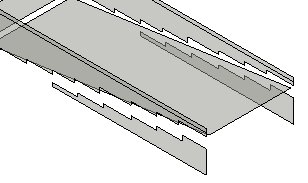When examining the energy model, you see jagged edges and small gaps between surfaces.
For example, the following image shows analytical surfaces created to represent a ramp and adjacent walls. The analytical surfaces for the walls show gaps where they are intersected by the ramp. The gaps have irregular edges.

The following image shows a different case in which analytical surfaces representing parts of a roof display irregular lines.

Issue: The form and precision of the analytical surfaces can be different in appearance to the typical closed shell geometry created manually by traditional energy modeling tools and processes. However, small gaps and jagged edges make little or no difference to the analysis. They exist primarily because of efficiency in the energy model creation process.
The areas of analytical surfaces used in the energy analysis are approximations of the surfaces of the model elements. The automatically generated energy model may contain gaps between analytical surfaces and jagged edges. These features of the energy model may look unusual, but they do not affect the accuracy of the results of the energy simulation.
In the Energy Settings dialog, the Analytical Surface Resolution option allows you to specify how precisely analytical surfaces match the surfaces of the building elements they represent. A smaller resolution value may align the analytical surface areas more closely with the surface areas of building elements. However, the change will result in an energy simulation that takes longer to complete but is not noticeably more accurate.
Solution: This issue does not require any action.